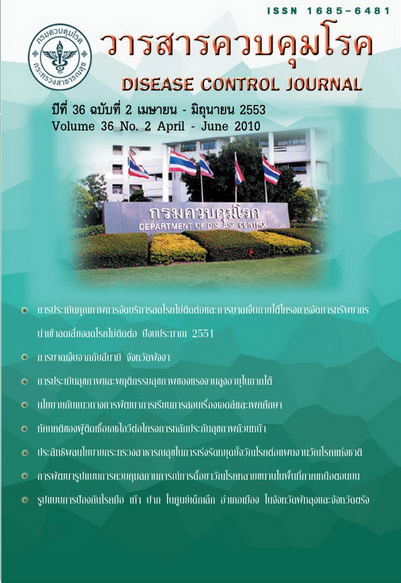Policy for Developing AIDS and Sex Education
Keywords:
Policy, AIDS and sex educationAbstract
This study was a qualitative research which aimed to compare AIDS and sex education policy and practice between central and region, to explain pattern and method including related factors of AIDS and sex education in each level. Data was collected from schools under Office of The Basic Education Commission, Ministry of Education by conducting in-depth interview from thirty key informants sampled by region with using semi-structured questionnaire. They consisted of deputy directors, supervisors of supervisor section and officers of promotion education section of Education service Area Office, school principals and teachers teaching AIDS and sex education. It was found that the policy and practices of AIDS and sex education in central and regions were transferred to 185 Education Service Area Offices but they had no clear practical guidelines, lacked continuous monitoring and evaluation, so its implementation in local areas didn't cover in every level. Pattern and method to teach AIDS and sex education in schools depended on directors of school and their team work. Crucial factors effecting achievement of AIDS and sex education were, 1 concrete policy, 2 curricula appropriated to local context , 3 capacity developing of teacher, 4.monitoring and evaluation, 5 budget support, 6 teaching media/tool and 7 giving information to parents. This study recommended to have concrete AIDS and sex education policy which covers all in-and-out of school youths, capacity building of teachers and their team to have positive attitude to AIDS and sex education and to deliver knowledge to youths effectively, local directions and community to accept teacher, promoting and developing understanding of realize advantage of AIDS and sex education and support continuously its implementation in every level
Downloads
References
2 สำนักระบาดวิทยา กรมควบคุมโรค กระทรวงสาธารณสุข การเฝ้าระวังพฤติกรรมเสี่ยงที่สัมพันธ์กับการติดเชื้อเอ็ชไอวี กลุ่มนักเรียน ด้วยเครื่องมือคอมพิวเตอร์มือถือ.นนทบุรี: สำนักระบาดวิทยา, 2551
3 สำนักวิชาการและมาตรฐานการศึกษา สำนักงานคณะกรรมการการศึกษาขั้นพื้นฐาน กระทรวงศึกษาธิการ รายงานการติดตามผลการดำเนินงานโครงการพัฒนาประสิทธิภาพ การจัดการเรียนรู้เพศศึกษาสำหรับเด็กและเยาวชน, 2550
4 องค์การแพธ.โครงการ "ก้าวย่างอย่างมั่นใจ" คู่มือการจัดกระบวนการเรียนรู้ เพศศึกษา. กรุงเทพฯ : องค์การแพธ (Path) ภายใต้การสนับสนุนของกองทุนโลก กระทรวงสาธารณสุข, 2547
5 กรมอนามัย กระทรวงสาธารณสุข. การสอนทักษะชีวิต กรุงเทพฯ: กรมควบคุมโรค, 2539. สถานการณ์ผู้ป่วยเอดส์ (ออนไลน์). แหล่งที่มา : http//www.epi.moph.go.th
6 สำนักการศึกษา กรุงเทพมหานคร. คู่มือปฏิบัติการสอนหลักสูตรเอดส์และเพศศึกษา ของกรุงเทพมหานคร. กรุงเทพฯ: ส่วนอนามัยเด็กวัยเรียนและเยาวชน สำนักส่งเสริมสุขภาพ กรมอนามัย กระทรวงสาธารณสุข, 2545.
7 สุถิรา มั่นคง. การพัฒนารูปแบบการสอนเพศศึกษาตามความสนใจของผู้เรียนในโรงเรียนมัธยมศึกษา วิทยานิพนธ์ปริญญามหาบัณฑิต สาขาการวิจัยการศึกษา มหาวิทยาลัยมหาสารคาม. มหาสารคาม, 2549.
8 องค์การแพธ. แนวทางการจัดการเรียนรู้เพศศึกษารอบด้านในสถานศึกษาสำหรับผู้บริหาร. โรงพิมพ์ เออร์เจนท์แทคจำกัด. กรุงเทพมหานคร,2550
9 คณะกรรมกรรมแห่งชาติว่าด้วยการป้องกันและแก้ไขปัญหาเอดส์. รายงานความก้าวหน้าระดับประเทศตามปฏิญญาว่าด้วยพันธกรณีเรื่องเอชไอวี/เอดส์. พิมพ์ครั้งที่ 2 โรงพิมพ์สำนักงานพระพุทธศาสนาแห่งชาติ, 2552
Downloads
Published
How to Cite
Issue
Section
License
Articles published in the Disease Control Journal are considered as academic work, research or analysis of the personal opinion of the authors, not the opinion of the Thailand Department of Disease Control or editorial team. The authors must be responsible for their articles.


.png)



